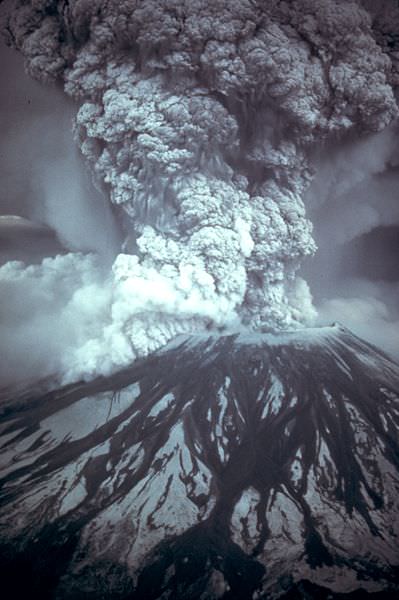[/caption]
The most powerful and devastating volcanic eruption in the history of the United States was the explosion of Mount St. Helens. This active stratovolcano, located in Skamania County, Washington detonated on May 18, 1980, killing 57 people, destroying hundreds of homes, and flattening hundreds of square kilometers of forest. The eruption tore off the top of the mountain, reducing its height from 2,950 meters to 2,550 meters.
Mount St. Helens is just one volcano in the Cascade Range of mountains that stretch down the west coast of North America. There are many other famous volcanoes in this region, like Mount Ranier, Mount Hood, and Mount Shasta. Helens is a large eruptive cone made up of several layers of lava rock interlaced with ash, pumice and other deposits. There are layers of basalt and andesite, and several domes of dacite lava have broken through.
Scientists believe that Mount St. Helens started forming about 40,000 years ago, and it’s considered the most active volcano in the Cascade Range. Before its eruption, St. Helens was the 5th-highest peak in Washington state; it was nicknamed the Mount Fuji of America. It measures about 10 km across the base and rose about 1,500 meters above the surrounding landscape.
And so, on May 18, 1980, Mount St. Helens erupted catastrophically, after nearly 2 months of local earthquakes and steam eruptions – scientists measured more than 10,000 minor earthquakes leading up to the eruption. But it was a magnitude 5.1 earthquake on May 18th that caused the volcano’s bulging north flank to slide away in the largest landslide in recorded history. This released a huge blast of hot gas, steam and rock debris that swept downhill from the summit. This pyroclastic flow melted snow and ice on the mountain, which added to the torrent of material streaming down the river valleys leading from the volcano. A plume of ash rose 19 kilometers into the air, covering 57,000 square kilometers of the Western United States.
Mount St. Helens is still active, and scientists have discovered dozens of extrusions of thick, pasty lava. A new dome is taking shape. It’s now about 1,100 meters in diameter and 250 meters tall.
We have written many articles about volcanoes for Universe Today. Here’s an article about Kilauea in Hawaii, and here’s an article about Krakatoa.
Want more resources on the Earth? Here’s a link to NASA’s Human Spaceflight page, and here’s NASA’s Visible Earth.
We have also recorded an episode of Astronomy Cast about Earth, as part of our tour through the Solar System – Episode 51: Earth.
References:
http://vulcan.wr.usgs.gov/Volcanoes/MSH/May18/summary_may18_eruption.html
http://vulcan.wr.usgs.gov/Volcanoes/MSH/Publications/Bulletin1859/eruption_may18_1980.html

